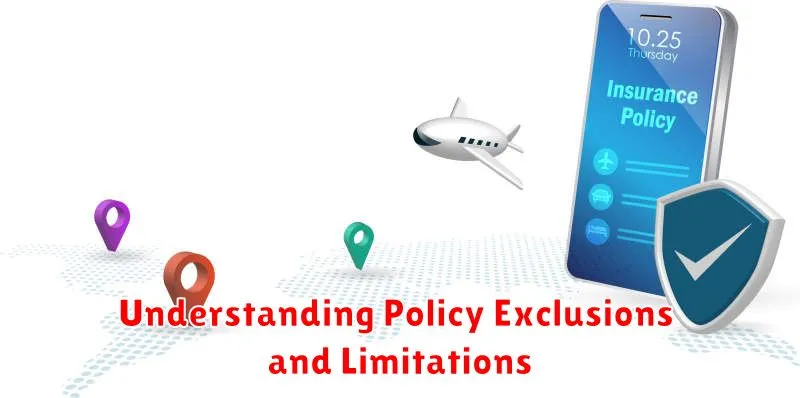Living the dream as a digital nomad means experiencing the world while working remotely. This freedom to roam comes with inherent risks, and it’s crucial to be prepared for unexpected events. Travel insurance is an essential safety net for any digital nomad, offering peace of mind and financial protection during your adventures. But with so many different policies available, it can be overwhelming to find the right one. This guide will equip you with the knowledge to choose a travel insurance plan that perfectly aligns with your nomadic lifestyle and ensures you’re covered no matter where your work takes you.
This guide will break down the essential aspects of travel insurance for digital nomads, including key coverage areas, important considerations, and how to find the best plan for your needs. We’ll explore the benefits of travel insurance, including medical emergencies, baggage loss, and travel disruptions. Additionally, we’ll delve into the specific challenges faced by digital nomads, such as remote work disruptions and the need for extended coverage. By understanding these factors, you can make an informed decision and travel with confidence, knowing you’re protected in case of any unforeseen circumstances.
Understanding the Unique Needs of Digital Nomads
Digital nomads, with their location-independent lifestyles, face unique challenges when it comes to travel insurance. Unlike traditional travelers, they often work remotely, making their livelihoods vulnerable to disruptions. They may also spend longer periods in different countries, exposing them to various risks over extended durations. Understanding these specific needs is crucial for digital nomads to secure adequate coverage and peace of mind while on the go.
Work-related Coverage: For digital nomads, travel insurance should go beyond the typical travel-related risks. It should cover disruptions to their work, including:
- Lost or damaged equipment: Laptops, smartphones, and other work devices are essential tools for digital nomads. Insurance should cover these items against theft, damage, and loss.
- Work interruption coverage: In case of illness, injury, or unexpected events, travel insurance should provide financial support for missed work days and project deadlines.
- Cybersecurity: Data breaches and online scams are constant threats. Travel insurance should cover the costs associated with data recovery, identity theft protection, and legal expenses.
Extended Travel Coverage: Digital nomads often travel for months or even years at a time. Traditional short-term travel insurance policies might not be sufficient. They need policies designed for long-term travel, offering:
- Extended coverage periods: Options for policies lasting several months or years are crucial for digital nomads.
- Medical coverage: With varying healthcare systems worldwide, robust medical coverage, including evacuation, is essential.
- Global coverage: Policies should cover travel to multiple countries, as digital nomads often work and explore different destinations.
Flexibility and Adaptability: Digital nomads’ itineraries can be fluid and unpredictable. Their insurance should reflect this by offering:
- Flexibility to change plans: Policies should allow for changes to travel dates and destinations without penalties or cancellations.
- Multi-trip options: Insurance should cover multiple trips within a specific period, accommodating frequent travel.
- Easy claims process: A streamlined and accessible claims process, ideally online, is crucial for digital nomads who might be on the move.
Essential Coverage for Digital Nomads
Digital nomads have unique needs when it comes to travel insurance, given their extended stays abroad and reliance on technology for work. Here’s what you should prioritize:
Medical Expenses: The most important coverage, especially for unexpected illnesses or injuries. Make sure your policy covers emergency evacuation and medical repatriation, as these can be incredibly costly.
Travel and Baggage: Protection against lost, stolen, or damaged luggage. Consider coverage for personal belongings, especially expensive electronics essential for your work.
Trip Cancellation and Interruption: Covers non-refundable travel expenses if your trip is disrupted by unexpected events like illness, natural disasters, or family emergencies.
Liability: Protects you against claims of accidental damage or injury to others, especially if you’re working from a rental property or coworking space.
Evacuation and Repatriation: Essential if you need to be transported back to your home country for medical reasons or due to a natural disaster.
Emergency Medical Services: Covers ambulance fees, medical consultations, and hospitalization.
Personal Accident Coverage: Provides benefits in case of death or permanent disability due to an accident.
Cybersecurity: Important for protecting your devices and data from theft or hacking. Consider coverage that includes identity theft protection.
Choosing the right insurance can be overwhelming, so it’s wise to consult with a reputable broker. Ensure your policy aligns with your specific travel plans and needs as a digital nomad.
Medical Emergencies: Ensuring Peace of Mind
One of the biggest anxieties for digital nomads is the potential for unexpected medical emergencies while traveling. Travel insurance is a crucial component of any digital nomad’s safety net, offering peace of mind in the face of the unknown.
Imagine you’re hiking in a remote area and twist your ankle, or fall ill with a severe stomach bug in a foreign country. Without travel insurance, you could face astronomical medical bills and the logistical nightmare of arranging transport and treatment.
Travel insurance acts as a safety net, covering medical expenses, emergency evacuation, and other essential services. It can provide financial protection and help you navigate complex medical situations in unfamiliar environments. Choosing the right travel insurance policy tailored to your needs and travel itinerary is essential. This ensures you’re covered for the specific risks you may encounter.
By investing in travel insurance, digital nomads can alleviate this worry, allowing them to focus on exploring the world and embracing the nomadic lifestyle with confidence, knowing they have a safety net in place should the unexpected occur.
Trip Cancellation and Interruption Protection
Trip cancellation and interruption protection is crucial for digital nomads, as it safeguards your investment in travel and provides peace of mind. This coverage reimburses you for nonrefundable travel expenses incurred if you need to cancel or interrupt your trip due to unforeseen circumstances.
Trip Cancellation Coverage protects you against unexpected events that force you to cancel your trip before departure. This could include:
- Serious illness or injury of yourself or a close family member
- Unexpected death of a family member
- Natural disasters impacting your destination
- Job loss or business closure
Trip Interruption Coverage kicks in if you have to cut your trip short due to covered events. This could include:
- Medical emergencies requiring immediate return home
- Natural disasters impacting your destination
- Family emergencies requiring immediate attention
Consider these factors when choosing trip cancellation and interruption protection:
- Coverage limits: Ensure the coverage amount is sufficient to cover your expenses.
- Covered events: Review the list of events that are covered by the policy.
- Exclusions: Understand what events are not covered by the policy.
- Waiting periods: Be aware of any waiting periods before coverage kicks in.
By securing trip cancellation and interruption protection, digital nomads can travel with confidence, knowing that their investment is protected against unexpected events.
Protecting Your Gear: Coverage for Electronics and Valuables

As a digital nomad, your electronics and valuables are your livelihood. They allow you to work, connect, and capture your experiences. Losing or damaging them can be a major setback, both financially and professionally. Travel insurance can provide crucial protection for your gear, giving you peace of mind on the road.
When choosing travel insurance, make sure the policy covers electronics and valuables. This coverage usually includes things like:
- Laptops, tablets, and smartphones
- Cameras and other photography equipment
- Jewelry and watches
- Other valuable items
It’s important to check the policy limits and any exclusions. Some policies may have a maximum amount they will cover for electronics, or they may exclude certain types of items. Also, be sure to understand what events are covered, such as theft, accidental damage, and loss.
Here are a few additional tips for protecting your electronics and valuables while traveling:
- Travel with a carry-on bag for your most valuable items.
- Use a lock for your luggage.
- Keep your electronics charged to avoid being caught without them.
- Back up your data regularly.
- Take photos of your electronics in case you need to file a claim.
Liability Coverage: Safeguarding Against Unexpected Events
As a digital nomad, you are constantly on the move, exploring new places and immersing yourself in diverse cultures. This adventurous lifestyle comes with its own set of risks, and it’s crucial to be prepared for the unexpected. Liability coverage plays a vital role in safeguarding you against financial burdens arising from unforeseen incidents. It’s an essential component of any comprehensive travel insurance plan.
Liability coverage acts as a shield, protecting you from legal and financial repercussions should you be held responsible for causing damage or injury to others. It’s a safety net that covers costs associated with legal defense, settlements, and judgments related to such incidents. Imagine this scenario: you accidentally bump into someone in a crowded market, causing them to drop their belongings and get injured. Liability coverage steps in to cover the medical expenses, legal fees, and any compensation the injured party might claim.
The scope of liability coverage varies between insurance providers, so it’s essential to carefully review the policy details. Some policies offer a set limit on the amount of coverage, while others provide broader protection with higher limits. You should also inquire about specific exclusions or limitations, such as coverage for certain activities or locations.
In the unpredictable world of travel, having adequate liability coverage can offer peace of mind and financial protection. It helps ensure that you are not burdened with unexpected expenses or legal battles, allowing you to focus on enjoying your travels and maintaining your adventurous spirit.
Travel Delays and Lost Luggage: Minimizing Disruptions
For digital nomads, travel is a way of life, and disruptions like delays and lost luggage can quickly derail productivity and enjoyment. Travel insurance plays a vital role in mitigating these challenges, offering financial protection and peace of mind.
Travel Delay Coverage steps in when unexpected events such as weather, mechanical issues, or strikes cause your flight to be significantly delayed or canceled. This coverage can reimburse you for expenses like accommodation, meals, and communication while you wait for your next available flight.
Lost Luggage Protection provides financial compensation if your bags are lost or damaged during your travels. This is particularly crucial for digital nomads who rely on essential equipment and belongings for their work.
By choosing a travel insurance policy with comprehensive coverage for travel delays and lost luggage, you can minimize the impact of these disruptions on your nomadic lifestyle. This allows you to stay focused on your work and travel plans, knowing that you have a safety net in place if the unexpected occurs.
Remote Work Considerations: Staying Connected
The allure of remote work lies in its flexibility, allowing you to work from anywhere in the world. However, this freedom comes with the responsibility of maintaining a reliable and secure connection to your work environment. When choosing your travel destinations, ensure that you have access to consistent and high-speed internet. This is crucial for seamless video conferencing, efficient file sharing, and uninterrupted work flow. Explore cafes, coworking spaces, or hotels that offer robust internet services, guaranteeing a smooth transition between travel and work.
Beyond the internet, consider the time zones of your clients or colleagues. It’s essential to manage your schedule effectively, accommodating potential communication overlaps and scheduling meetings at times convenient for everyone involved. Tools like Google Calendar and Slack can help you streamline communication and stay on top of deadlines, even when navigating different time zones. By carefully considering these aspects, you can maintain a healthy work-life balance and ensure continuous productivity while on the move.
Long-Term Travel Insurance: Options for Extended Trips

If you’re a digital nomad or planning an extended trip of several months or more, standard travel insurance won’t suffice. You’ll need long-term travel insurance, designed to cover you for the duration of your travels and the unique risks associated with extended stays abroad.
Several options are available for long-term travel insurance, each with its own benefits and drawbacks. Here are the most common:
- Multi-trip policies: These offer coverage for multiple trips within a year, ideal for frequent travelers.
- Annual travel insurance: This provides continuous coverage for a set period, typically a year.
- Specific destination policies: Designed for extended stays in specific countries or regions, these policies often offer tailored coverage.
- Backpacker insurance: Tailored for budget travelers, these policies often include coverage for adventurous activities.
When choosing long-term travel insurance, consider factors like your travel duration, destination, activities, and budget. Evaluate the coverage offered, including medical expenses, evacuation, baggage loss, and liability.
Choosing the Right Policy: Factors to Consider
Choosing the right travel insurance policy can be daunting, especially with so many options available. To ensure you’re properly covered, it’s essential to consider several key factors.
Firstly, assess your travel itinerary. Are you visiting multiple countries? Will you be engaging in any adventurous activities like hiking or scuba diving? Some policies have limitations on coverage for certain activities, so it’s crucial to choose a plan that aligns with your travel plans.
Secondly, consider your personal health and medical history. If you have pre-existing conditions, you’ll need to look for a policy that offers sufficient coverage for these, as some policies may exclude or have limitations for pre-existing conditions.
Thirdly, evaluate your budget. Travel insurance policies vary greatly in price, ranging from basic plans to more comprehensive ones. Consider what level of coverage you’re comfortable with and how much you’re willing to spend for it.
Lastly, pay attention to the policy’s exclusions. All travel insurance policies have limitations, so it’s essential to read the fine print and understand what’s covered and what’s not. This includes things like pre-existing conditions, adventure sports, natural disasters, and political unrest.
By carefully considering these factors, you can choose a travel insurance policy that provides the necessary protection for your travels, offering peace of mind as you explore the world as a digital nomad.
Comparing Insurance Providers: Finding the Best Fit

Choosing the right travel insurance provider is crucial for digital nomads, as it safeguards you against unforeseen circumstances while you’re on the move. With countless providers offering diverse plans, comparing them can be overwhelming. To navigate this effectively, consider these key factors:
Coverage: Evaluate what each plan covers, including medical expenses, evacuation, lost luggage, trip cancellation, and personal liability. Ensure it aligns with your specific travel needs and activities.
Exclusions: Pay close attention to what activities or situations aren’t covered. Many plans exclude certain adventure sports, high-risk destinations, or pre-existing medical conditions.
Premiums: Compare premium costs based on factors like age, destination, trip duration, and coverage level. Remember, the cheapest option isn’t always the best, especially if it compromises essential coverage.
Customer Service: Read reviews about providers’ customer service responsiveness and claims processing efficiency. A reliable provider should be easy to contact and offer prompt assistance in case of emergencies.
Reviews and Ratings: Research providers’ reputations and customer reviews on websites like Trustpilot or Consumer Reports. Look for providers with consistently positive feedback and a track record of handling claims fairly.
Digital Nomad-Specific Plans: Some providers offer plans tailored for digital nomads, addressing their unique needs like working remotely, extended trips, and potential equipment damage. These plans might provide more comprehensive coverage for specific situations.
By diligently comparing providers based on these factors, digital nomads can find the travel insurance plan that offers the most suitable coverage, value, and peace of mind for their adventures.
Understanding Policy Exclusions and Limitations

Travel insurance is essential for any digital nomad, offering peace of mind and financial protection while you’re exploring the world. However, it’s crucial to understand the policy exclusions and limitations to ensure you’re adequately covered. These are situations or circumstances where your insurance may not provide coverage.
Common policy exclusions include:
- Pre-existing conditions: Some policies may not cover medical expenses related to conditions you had before purchasing the insurance.
- Dangerous activities: Activities like extreme sports, skydiving, or scuba diving often fall outside standard coverage.
- Travel to high-risk areas: Some policies may not cover travel to destinations with high levels of political instability or health risks.
- Acts of war or terrorism: Many policies exclude coverage for events related to war or terrorism.
Limitations might include:
- Maximum coverage limits: Policies often set a maximum amount they will pay out for specific incidents, like medical expenses or lost luggage.
- Deductibles: You may be required to pay a deductible before your insurance covers the rest of the costs.
- Waiting periods: There might be a waiting period before certain benefits, like medical coverage, become effective.
It’s essential to read your policy carefully and understand what is and isn’t covered. Contact your insurance provider if you have any questions or need clarification. By being aware of these exclusions and limitations, you can choose the right policy for your needs and avoid any unpleasant surprises later on.
Tips for Filing a Claim: A Step-by-Step Guide
Filing a travel insurance claim can be a stressful process, but it doesn’t have to be. Following these steps will ensure you have all the information needed to make a smooth claim:
1. Contact your insurance provider immediately. The sooner you report your claim, the better. Most insurance providers have a 24/7 emergency hotline you can call for immediate assistance. Be sure to have your policy information handy.
2. Gather all relevant documentation. This includes:
- Your policy details
- Proof of your trip, such as flight tickets or accommodation bookings
- Medical records or receipts, if applicable
- Police reports, if required
- Any other relevant documents
3. Complete the claim form. Your insurance provider will likely have a claim form online or a downloadable PDF. Fill it out carefully and accurately. Make sure you provide all requested information and supporting documents.
4. Submit your claim. Once you have completed the claim form and gathered all the necessary documentation, submit it to your insurance provider as instructed. You can typically do this online, by mail, or by fax.
5. Follow up with your insurance provider. After you have submitted your claim, keep track of the process and follow up with your insurer to check the status. This will help to ensure that your claim is processed efficiently.
6. Understand the claim process. Most insurance providers have a process for handling claims that can vary depending on the type of claim. Be sure to understand the process outlined in your insurance policy.
By following these steps, you can increase your chances of having a successful claim and receiving the compensation you need.

